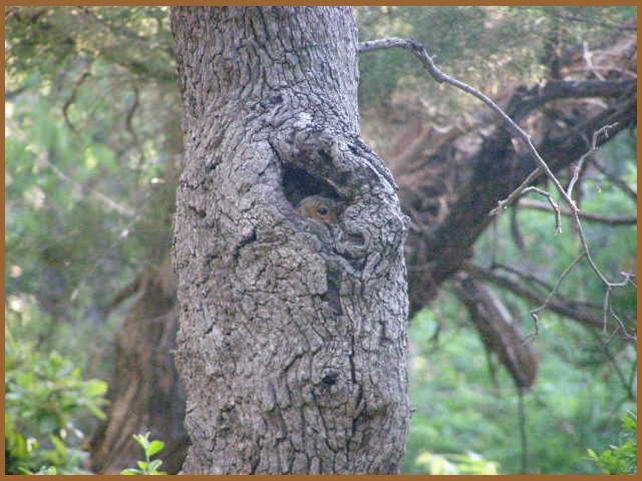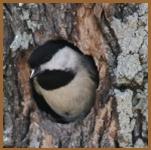Guide to SA Natural Areas & Greenway Trails
C. Th e Importance of Snags

COSA Parks and Recreation Department’s Park Naturalist Wendy Leonard wrote this piece and took the picture above.
SNAGS = STANDING DEAD TREES
The saying “home is where the heart is” has never been more true than its meaning in nature. For many animals, home can be the heartwood of dead or decaying trees. Dead trees still standing in the forest are called snags. Snags provide home and refuge for many animals including birds, amphibians, reptiles, and mammals.
SNAGS = HOMES FOR BIRDS & MAMMALS
There are over 85 species of North American birds that use cavities in snags and decaying trees as their home¹. A very few species including woodpeckers and nuthatches are Primary cavity nesters who have to excavate their own cavities; snags provide the perfect medium for this activity. These primary cavity nesters will rarely nest in cavities that they themselves did not excavate. If snags are not available for excavation, they may not be able to nest or to roost².
Many more species are Secondary cavity nesters such as the Eastern Bluebird and the Carolina Chickadee who cannot excavate cavities for themselves; thus, they rely on the primary cavity nesters to carve out a home in a dead or dying tree².
Do only birds make use of snags and tree cavities?
These cavities are home not only for numerous bird species, but also for many mammals such as squirrels and ringtails, both of which live in Phil Hardberger Park. Lizards such as the Texas Spiny Lizard, or Tree Lizard, take refuge in these cavities as well.
ROTTEN WOOD IS A HOME, TOO!!
Cavity nesters are an important part of the forest ecosystem, because many of them are insectivorous and keep forest pests in check². After a snag has rotted enough to fall to the ground, its role of providing a home does not end. Once on the forest floor, it encourages an entirely new ecosystem to begin. This rotten wood now becomes home for fungi, earthworms, fireflies, toads, and even salamanders—all the while recycling nutrients back into the earth³.
THAT'S WHY WE LEAVE SNAGS
What lessons do we learn from Mother Nature about recycling?
In the past, snags were removed from forest ecosystems. However, as we learn more and more about their importance, snag retention has become an increasingly important part of maintaining a healthy ecosystem. As you look around the forest floor, know that the dead wood you see can sustain as much life as a living tree³.
_________________________
1 Wildlife in Connecticut: Wildlife Habitat Series. 1999. Snags for Wildlife. Connecticut Department of Environmental Protection: Wildlife Division.
2 Jones, E.J. et al. 1994. Snags and the Downed Logs: Working With Wildlife. North Carolina Cooperative Extension Service.
3 Parker, M.O. 2011. Skill Builder: Dead Wood Supports Life. Texas Parks and Wildlife Magazine.

Carolina Chickadee. Photo by Susan Morgan